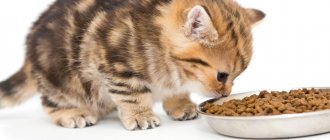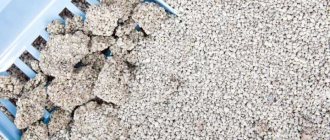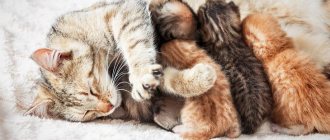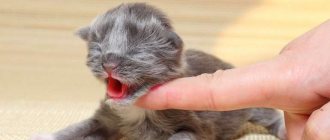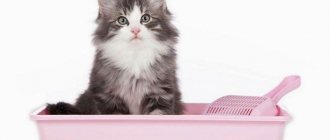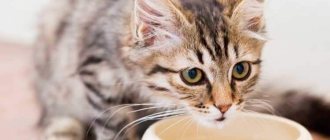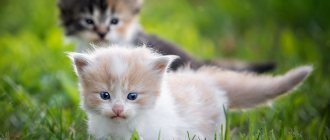The age of a kitten is 3-4 months - this is a rather busy period in the life of a four-legged friend. At this time, the babies usually end up in a new home and move from the breeder to the owner. There is an active growth phase. Muscle development is in full swing. Preparations are underway for the replacement of milk teeth with molars. The kitten is still just as active, spending a lot of strength and energy on understanding the world around him. At 3-4 months, the pet’s body is very vulnerable, as the immunity the kitten received from its mother loses its strength. At this time, the enzyme capable of digesting milk is lost.
In the midst of all these events, it is especially important to protect the kitten from adverse factors. At this stage of a little fluffy’s life, improper feeding can lead to a number of complications: indigestion, improper development of teeth, weakness of the bone and muscle system, etc. To avoid this, it is necessary to provide the kitten with the opportunity to eat properly and in a balanced manner. The diet must meet all the needs of a growing body. By the age of 3-4 months, you need to decide on the type of feeding and stay on it.
Features and rules of feeding
It is necessary to feed a kitten at 3-4 months in accordance with certain rules:
- Meals should be done frequently, but in small portions.
- Feed food at room temperature.
- The diet is enriched with vitamins and minerals. If necessary, we provide them additionally.
- Clean, fresh water is freely available.
- Overeating or undereating should not be allowed. This can cause complications such as developmental delay syndrome if the body does not get enough nutrients and excess weight if the body gets too many nutrients.
- It is necessary to give foods that the kitten will chew, thereby massaging the gums.
Training a kitten from 3 to 6 months
The period between three and six months is important for teaching the kitten where it can and cannot go in the house, what objects it can play with, and how to respond to its name.
Treats, verbal praise and affection should be used to reinforce good behavior.
Litter box training should be natural, but there are special litters designed to attract kittens. Make sure your kitten can get in and out of litter boxes and knows where to find each one in the house.
If you have one kitten, you should have at least two litter boxes in different locations, ideally on each floor of the house.
Norm and feeding regimen
A kitten at this age does not feel when it is full and has a constant feeling of hunger. To prevent overeating, it is necessary to feed him strictly according to the norm. We feed a three-month-old kitten a daily portion in 5-6 meals. Of these, there may be 3 main meals and 2-3 snacks. Later you can start switching to 4 feedings a day.
The daily food intake at the age of 3-4 months is calculated as 150-200 grams per 1 kg of animal weight. The norm is selected individually, since pets differ in activity and weight. So, for example, for a medium breed kitten at the age of 3 months, 170 grams will be enough, but for a large breed kitten at 4 months, 200 grams may not be enough.
Health and care of a kitten from 3 to 6 months
The kitten should have already had its first veterinarian visit and received its first FVRCP shot at about two months of age, but that's not all a growing kitten needs. Three to four weeks after the first vaccination, or around three months of age, a second FVRCP vaccination is given.
After about a month, the final FVRCP vaccination is given along with the rabies vaccination. During these three months, your veterinarian may also discuss other vaccination options with you, depending on your kitten's lifestyle and risk of infection. These vaccinations are incredibly important to help keep your kitten healthy.
Spaying and neutering are very common surgical procedures, and most kittens will have undergone one of these procedures by six months. Females are spayed and males are castrated, but both operations involve the removal of reproductive organs.
With the removal of these organs, fewer sex hormones are produced, the cat is unable to reproduce, and the risk of many cancers is eliminated or greatly reduced.
Your veterinarian will advise you on the best time to spay or neuter your kitten and may also recommend pre-operative blood screening before surgery.
This blood screening will not only show whether the kitten is healthy enough for anesthesia, but will also establish a baseline of normal values for the kitten. These baseline values will be useful for comparison of future blood tests.
It is important to start preventing parasites as soon as they are old enough or gain enough weight. Talk to your veterinarian about options for preventing intestinal parasites, fleas, ticks and heartworms at your first veterinarian visit. These medications are often given to your kitten monthly, but some are needed less frequently.
How to feed a kitten
At this age, the kitten should eat the same type. This means that you need to stick to feeding either natural food or ready-made food. When moving to a new home, the baby should be kept on his usual diet. When a new owner decides to transfer his four-legged friend to a different type of food, he should start doing this gradually, after a month. This is due to the fact that the kitten needs some time to adapt to new conditions. Next, we’ll look at what to feed a 3-month-old kitten.
Don't forget about the drinking regime. Make sure your kitten always has access to water. When feeding natural food and wet prepared foods, the body's need for water is not high. If you feed your pet mostly dry food, then he needs 2 or even 4 times more water.
The main thing about a kitten from three to six months
Habits and character
A kitten at three months is quite independent. Usually the baby is already accustomed to the tray, uses a scratching post, and has successfully switched from mother's milk to kitten food. Breeders often start giving away kittens from the age of three months.
If you become the proud owner of a furry four-legged friend, make sure that the veterinary passport contains notes on the necessary vaccinations. Find out in detail what he was fed recently. Experts advise that after moving to a new place of residence, do not disturb the kitten too much and feed it for the first 10 days with the same thing that the baby was fed before. For a baby, a new home is very stressful. If you don’t put pressure on your ward, he will soon begin to explore the surrounding space on his own.
Games and communication will help you make friends with a new family member. Toys for little kittens are an opportunity to develop hunting skills, socialize, and get comfortable. Felinologists recommend light toys for kittens - such that the baby does not have to work hard to toss the toy with his paws. Toys should not be small or too hard - at the moment of changing baby teeth to molars, your child will probably want to chew on them. It is important that they do not have parts that can be chewed off and swallowed. It is better to purchase toys for small kittens at a pet store - this guarantees you the quality and safe composition of the product.
At the age of three to six months, the muscular and bone skeleton is actively formed. Toys such as mice and laser pointers will help develop mobility and strengthen muscles. If the kitten guesses that you are in charge of the process, put the game aside for a while. By the next time, the baby will have already forgotten about his guess and will start chasing the bait again.
You can purchase a whole play set for a kitten at a pet store. Even if you are not nearby, the kitten will be able to train and move - climb on special posts and platforms installed at different heights. Whatever the toys for your pet, the most important thing is to use them more often in play and communication with your four-legged friend. Kittens desperately need affection, attention from their owner, and active games.
Surround your baby with your care and love. But do not forget that from the first days in the new home he needs to be gradually and gently taught the rules of communication with family members and the rules of behavior in the house, convey what can and cannot be done.
The main thing is, under no circumstances punish the kitten or use physical force. Babies have a short-term memory, and after just a few seconds of misconduct, the baby will completely forget about what he did and your dissatisfaction will become a bolt from the blue for him. Kittens subtly sense the state of their owner, respond sensitively to him - and punishment will really become a huge stress for him, which will undermine his trust in you.
This does not mean that all missteps need to be let off the kitten’s paws. You just need to act smoothly and carefully. Forget about using force - it never leads to anything good. It is better to work with intonation, clapping, and, as a last resort, “scare” the kitten with a spray bottle. Stop unwanted behavior only when you catch the kitten in the act. For example, when he sits down to do his business in the wrong place. But after a couple of minutes after this, reprimanding is completely pointless.
Be friendly, but confident and consistent. If you forbid something to a kitten, then forbid it forever. Do not make concessions, otherwise the baby will never understand what behavior is correct. Do not allow your pet to bite or scratch your hands even during play - so that this habit does not continue in the future. It is unlikely that you will like it if an already matured cat jokingly mistakes you for a palm tree and climbs up your leg, leaving red marks.
Teeth and nutrition
In the period from three to six months, not only muscles and bones grow, but also the teeth of the little hunter. At three months, a kitten has a full set of 26 baby teeth. At three to five months, they will gradually begin to be replaced by indigenous ones. The process will be completed by approximately eight months of age. Examine your pet's teeth. The change from milk to molar usually goes smoothly in kittens, but minor problems such as swollen gums are best detected in a timely manner.
Decide on the kitten's feeding schedule. This can be special ready-made food for kittens or food “from the table”. Complete food is developed taking into account all the needs of the developing kitten's body. Choose the highest quality food - this is the key to your pet’s health. The packaging always indicates the age of the kitten by month, so be sure to pay attention to this. The table feeding plan should be discussed with your veterinarian. In this case, in addition to food, the baby will need vitamins. Don't forget to provide your baby with constant access to clean, fresh drinking water.
How many times a day should you feed your kitten? At three months, it is absolutely normal to feed your baby five to seven small meals a day. At four months you can switch your pet to four meals a day. By five months, your child is ready to switch to three meals a day. Make sure your baby eats well, but does not overeat. With the right diet, the kitten will grow up healthy, beautiful and will not suffer from excess weight, as well as other diseases that overeating can cause.
Development and health
Typically, kittens begin to receive their first vaccinations against infectious diseases at two months of age. The drugs are produced in the form of complex vaccines containing 3-4 components, this allows several injections to be replaced with one. Revaccination is carried out after three weeks. As a rule, breeders carry out these procedures before transferring the kitten to new owners. If for some reason the vaccinations were not done, then they need to be done as soon as possible.
Rabies vaccination is recommended at 3-4 months of age. The pet's vaccination schedule can be adjusted by the veterinarian depending on the chosen drug (vaccine). Vaccination is carried out only to clinically healthy animals.
Even if the kitten’s veterinary passport contains notes on all necessary vaccinations and treatments, carefully follow the schedule of revaccinations and treatment against external and internal parasites. Revaccinations after the first year of life are then performed once a year. The choice of vaccination schedule and required types of vaccines is made only by a veterinarian.
At six months, kittens gradually begin puberty. At the age of 7 to 10 months (less often at the age of one year), cats begin their first heat. This is how puberty begins, but this does not mean that the young cat is ready to become a mother. The body continues to form, so it is recommended to breed a cat only after several heats. Some owners prefer to sterilize at the age of six months. This can be done a little later, but the older the cat is, the more difficult it will be for her to undergo the operation. Males are usually neutered at the age of eight to ten months, preferably before one year of age.
A teenage kitten needs to be taught regular hygiene procedures. If you need to examine and rinse or clean the kitten’s eyes and ears, praise your ward and speak kindly to him. Finish the ritual with praise and a treat for your pet.
The same goes for combing. A slicker or furminator should not frighten the kitten. If you first play, praise and treat your baby with something, he will perceive the brushing as a sign of your attention to him. A small kitten has almost nothing to comb. But a teenage kitten will begin its first molt at the age of five to eight months. If combing is something familiar for your ward, then changing the fur to an adult will not be accompanied by hairballs throughout the house. The danger is that your four-legged friend may swallow his own fur.
By the time the baby molts, the baby's color will begin to even out a little. By 10 months, your pet's color will be almost final. Kittens develop eye color by four months. Then it may become somewhat richer.
Already at 4-8 weeks of life, kittens can have their first nail trimming. This is done to prevent kids from injuring each other while playing. If you have never shortened a kitten’s claws before, it is better to entrust it to a specialist, at least for the first time. At home, your pet will be able to scratch the scratching post. Most kittens are advised to buy a horizontal scratching post - this will make it easier for the baby to reach.
After three months, the kitten stops growing rapidly and changing every week. By six months his growth slows down. Then it will get stronger, muscles will develop, and the fat layer will increase slightly. But if you have already managed to raise an active, intelligent, healthy six-month-old kitten, then you have overcome the most difficult challenges together and become true friends.
Natural nutrition
Natural feeding can be called nutrition that is balanced using a number of products.
Thus, meat, fish, and eggs are considered protein foods. Fats are found in egg yolks, offal and butter. Carbohydrates can be replenished with cereals: buckwheat, rice, oatmeal.
Include foods that are approved for feeding to cats in your diet. When introducing a new component into your diet, pay attention to your stool. Eating foods containing salt, pepper, as well as fried and spicy foods is strictly prohibited.
Pros of natural feeding:
- The owner knows for certain what he feeds the pet.
- Natural composition.
Disadvantages of natural feeding:
- You need knowledge, and most importantly time to cook.
- Food spoils quickly.
- Additionally, it is necessary to give vitamins and minerals.
When compiling a natural diet for what to feed a kitten at 3-4 months, you need to include the following products:
- Lean meat (beef, poultry, rabbit), always well cooked.
- Cottage cheese or yogurt without additives, low-fat or with the lowest percentage of fat content.
- Vegetables and fruits (carrots, pumpkin, zucchini, cabbage, green apples, cucumber and more).
- Porridge with water or meat broth.
- Egg yolk or whole quail eggs.
- Liver and sea fish, but not more than once a month.
Can I give it to a kitten - food table
| Product | Can I give it to a kitten? |
| Banana | No |
| Borsch | No |
| Broccoli | Yes |
| Buckwheat | Yes |
| Baby food | Yes |
| Potato | No |
| Kefir | Yes |
| Food for adult cats | No |
| Semolina | No |
| Milk | No |
| Carrot | Yes |
| Oatmeal | Yes |
| Cucumber | Yes |
| Liver | Yes |
| Tomato | Yes |
| Rice | Yes |
| Fish | No |
| Ryazhenka | Yes |
| Sour cream | No |
| Soup | Yes |
| Raw meat | Yes |
| Cottage cheese | Yes |
| Grass | No |
| ground meat | Yes |
| Bread | No |
| Chocolate | No |
| Apple | Yes |
| Egg | Yes |
What not to feed a kitten
Some owners who do not know how to properly feed kittens give them foods that are undesirable for consumption.
- Salted, fried, smoked, peppered, spicy, fatty. These foods cause inflammation of the digestive tract.
- Milk. At the age of 3-4 months, it is better to give it up, since the kitten’s digestive tract is no longer able to digest lactose.
- Citrus. They are not digestible in cats. Moreover, they cause irritation of the mucous membrane of the stomach and esophagus, which leads to an attack of vomiting followed by dehydration.
- Bones. Cats chew bones into many fragments, which pass through the gastrointestinal tract and injure the mucous membrane. As a result, bleeding may occur.
- Chocolate and other sweets. They have a toxic effect on the kitten’s body.
- Vegetables of the nightshade family, as well as onions and garlic. The body does not digest these foods.
- Avocado, grapes and raisins. They contain a poisonous toxin.
How to determine if a diet is suitable for your pet
It is possible to assess whether the food chosen by the owner is suitable for the animal approximately a few weeks after its introduction into the diet. A certain finished product may not be suitable physiologically - that is, it may be poorly absorbed, the kitten may be allergic to it, or the pet may simply not like it. If everything is in order, then:
- the animal is active and has a healthy appearance - the eyes and ears are clean, the fur is shiny;
- the pet eats with appetite and eats the required amount of food;
- the kitten has no digestive problems - flatulence, diarrhea or constipation, vomiting, colic.
If there are allergies or physiological problems, the food should be replaced with another. If the symptoms recur, the pet will have to be switched to natural food. Accustoming to new food should be done gradually. Over the course of a week, you need to mix the new finished product with the old one, gradually increasing the amount of the new one. You should carefully monitor your pet's condition. During the transition to a new diet, some digestive problems may occur, but if the food is suitable, they should go away within 2-3 weeks.
Ready-made feed
The composition of industrial feeds is already balanced. This diet is enriched with vitamin and mineral supplements necessary for the development of the kitten. There are dry and wet food. When feeding, it is better to give preference to one type of food. If you still decide to use both dry and wet food, then separate them and feed them at different meals.
Advantages of ready-made feed:
- Convenience. Such food saves time that would have to be spent on cooking.
- The feed is already balanced.
- When eating dry food, the kitten actively works with its jaws, which puts the necessary load on the entire oral apparatus. This stimulation promotes proper development of the jaw muscles and bones.
- Among the ready-made foods there is a large selection of lines according to the tastes and physiological state of the pet.
Disadvantages of ready-made feeds:
- High quality feed has a high cost.
- It is difficult to choose food among a large number of different brands.
- Dependence on economy-class flavor enhancers is developing.
Rules for feeding a 3 month old kitten dry food:
- Feed should be given in accordance with the norm indicated on the package.
- The food must correspond to the type of animal, its age and physiological condition.
- It is better to feed the same brand and line of food.
- When feeding dry food, clean water should be nearby.
- Food should not sit in a bowl; such food becomes of poor quality.
Acana
Canadian-made food belongs to the super-premium class. The composition is good, does not contain cereals. Fresh (8%) and raw (8%) meat, fresh whole eggs (8%), as well as dehydrated poultry (8%), and offal are used as a source of protein. The total amount of protein products is 35%. There are useful ingredients such as: apple, pear, cranberry, brown algae, carrots, pumpkin and others.
Only dry food with fish, lamb and chicken flavors is available for sale.
The feeding rate for kittens 5-20 weeks is 60 grams per kg of weight.
Royal Canin
Premium food. The protein content in wet food is 10-12%, and in dry food 36%. The protein in this food is mainly vegetable. Excess amount of carbohydrates. There are also corn flour, dry beet pulp, and soybean components.
This brand of food contains mainly poultry meat. Royal Canin brand food is presented in the form of canned pates, wet and dry ready-made food.
For babies aged three months, you should choose Royal Canin MOTHER&BABYCAT food - this food is perfect for feeding kittens from 1 to 4 months. For a four-month-old kitten, Royal Canin Kitten food is suitable. This food can be fed to kittens from 4 to 12 months.
During the day, the baby will need 50-65 g and 55-70 g, respectively.
Bosch Sanabelle Kitten
This food belongs to the same class as Royal Canin. The composition contains all the necessary components. Fresh poultry meat – 25%, fresh liver – 5%. The composition is enriched with fiber, eggs, animal fats, calcium supplements and brewer's yeast. Also in the list of ingredients there are those that can cause allergies - these are maize and cellulose.
Kittens can eat this food for up to a year, and it is also suitable for pregnant and lactating cats. You can choose either dry food or wet food.
The feeding rate is 55-60 g and 60-65 g, respectively.
Feeding 3 month old kittens with special food
Three month old kittens need to be fed good foods to reduce the possibility of an allergic reaction. To do this, it is better to purchase premium and super-premium food, as well as holistic foods.
Premium kitten food
This group of feeds includes many products:
- Royal Canin. A widespread brand on the domestic market, which has a fairly low price. The line includes a variety of foods, including for kittens 3 months old.
- Hills. American product with food for small kittens. Dietary products can be purchased.
- Purina ProPlan. They use only natural meat. There are food for sick animals and small kittens.
- Eukanuba. The optimal combination of cost and quality. You can find kitten foods in a variety of flavors.
- Bozita. Swiss high quality food with a fairly low price.
Super premium kitten food
This is the best option for a kitten. These include the following companies:
- 1st choice. Canadian company producing food with high quality natural products.
- Bosch Sanabelle. German manufacturer of high quality feed.
- Arden Grange. The food contains meat and cereals, and probiotics are also added to the product.
Holistics
These are foods that are made without the use of preservatives, dyes and other “chemicals”. Ideally, even by-products and cereals are not added there. Due to the lack of preservatives, these foods spoil very quickly, so they are sold in small portions. In addition, the absence of flavorings and flavoring additives does not mean that the food will not cause allergies or will provide everything the kitten needs. So in fact, these foods are often not superior to super-premium products. These include Eagle Pack and Go Natural holistic.
